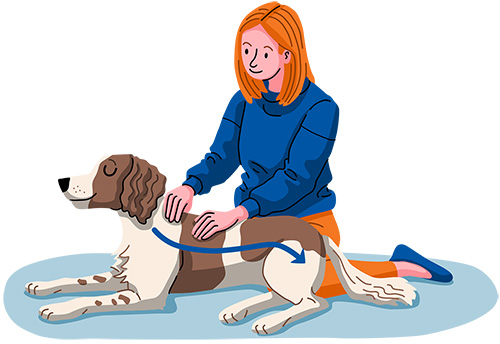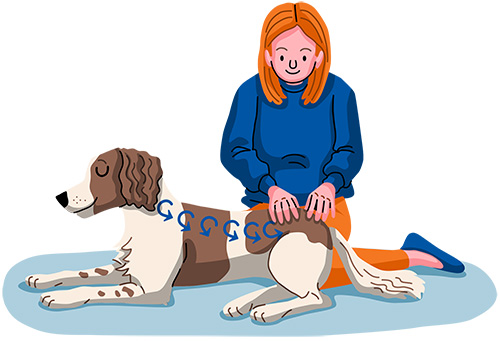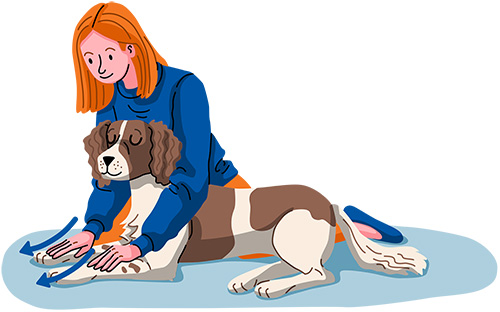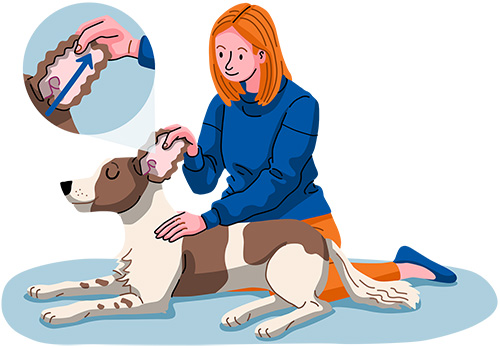A canine massage is a great bonding opportunity, and a chance to soothe your dog’s muscles. Here’s how to get started massaging your dog.
From easing stress and anxiety to boosting blood circulation and strengthening the bond between you and your dog, massage is a great addition to your dog’s routine. Discover more about the benefits of this technique, plus how to massage your dog.
Benefits of dog massage
Massaging your dog offers plenty of physical and mental benefits, including:
- Bonding: When you massage your dog, their body releases endorphins, the body’s ‘feel good’ chemicals. This can make your dog feel relaxed and is a great way to strengthen the bond between you.
- Pain relief: Massage can help soothe your dog’s sore muscles by increasing blood flow to the area being massaged.
- Stress and anxiety relief: The pressure and hands-on contact of massage can help soothe some anxious dogs.
- Early identification of health issues: Regular massage can help you quickly identify any areas of soreness, swelling or pain, which can indicate health issues that may need vet support.
When to massage your dog
Some dogs will never say no to a massage! But there can be certain times when a massage is particularly beneficial, including:
- Before strenuous activity: Massage increases blood circulation to muscles, which can help reduce the risks of injuries.
- After strenuous activity: Massage can help soothe any post-exercise stiffness, and is particularly beneficial for older dogs or those recovering from injuries.
- For anxiety relief: If you know your dog will be anxious or stressed – from loud noises, new experiences or a trip to the vet – a short massage before or during these events can help soothe and calm your dog.
- For pain relief: Sore joints can benefit from a light massage, but be careful to use gentle pressure and stop if your dog seems uncomfortable.
How to massage a dog
Step 1: Choose a quiet area of your home, where your dog typically likes to relax. The best time for your dog’s massage is when they’re already calm and quiet, so just before bedtime is ideal. Make sure your dog has been to the toilet and hasn’t had anything to eat for half an hour before you start.
Step 2: Start by pressing your flat palms against a part of your dog’s body that they usually enjoy having touched, for example, their shoulder or neck. Sweep your palms down your dog’s body and legs, noting any swelling, heat, or signs of pain. If your dog seems uncomfortable or walks away, stop the session now.

Step 3: Sweep your hand down your dog’s body again, increasing the pressure slightly. Repeat five times, using a level of pressure that your dog enjoys.
Step 4: Now use your fingertips to apply gentle pressure in small circles. Start at the back of your dog’s neck, moving to their shoulder blades, then along one side of the spine moving towards the base of their tail. Do the same on the other side, taking care not to apply any pressure on the spine or other bony areas. If your dog enjoys this, you can repeat this step a few times.

Step 5: Sweep your hand down your dog’s front legs, applying gentle pressure. Repeat a few times. Massage their shoulder muscles with a circular motion. Repeat with their back legs and thigh muscles. If your dog doesn’t like having their legs touched, skip this step.

Step 6: Massage your dog’s ears by placing the base of their ear flap between your thumb and forefingers, before sliding your fingers towards the tip of their ear. Repeat five times.

However, should your dog seem uncomfortable with the massage, please stop immediately.
How often should you massage your dog?
Aim for monthly sessions to start, but if your dog really enjoys it, you can massage them weekly or even daily. If you’re using massage for specific reasons, for example before exercise or to help your dog when they’re feeling anxious, time your sessions to coincide with this.
Massage is a great way to bond with your dog, but if they need specialist support when recovering from an injury, it’s always best to speak with your vet and work with a qualified canine therapist. If you have dog insurance with Petplan, you can also speak with a qualified expert by logging into the Pet Expert Chat service through your My Petplan account.
Does your dog enjoy a massage session? Let us know on our Facebook page.
